NEWS:
Morávka River after May’s flood
Spring’s flood affected also Morávka River basin. Especially NPP Skalická Morávka was changed beyond recognition. Water flushed away all vegetation from alluviums and created many new gravel alluviums. Now is there possible to see, what really means wild and branching gravel-bearing River.
Thanks discontinuous innovations of weather in the first June’s week can employers of Salamandr and suppliers of the partners of project start with chemical elimination of Reynoutria spp.
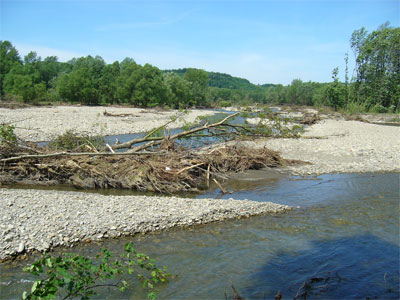
Morávka after flood, 10.6.2010, photo: Štěpánka Konupková Kalousová
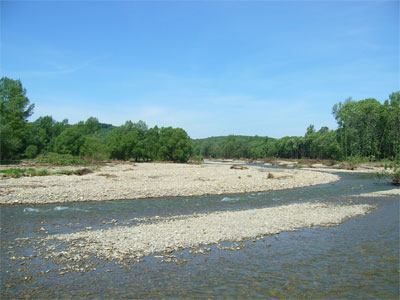
New gravel alluvium , 10.6.2010, photo: Štěpánka Konupková Kalousová

Shrubs out planting in Morávka river basin
Others 500 pieces of shrubs were planted in Morávka river basin in the term of action C3 on days 15.4. and 16.4. 2010. There were used these species: Purple Willow (Salix purpurea), Goat Willow (Salix caprea), Crack Willow (Salix fragilis), Common Osier (Salix viminalis), Almond Willow (Salix triandra), Common Dogwood (Cornus sanguinea), European Spindle (Euonymus europaeus). On the pictures you can see this year’s willows and willows planted in 2008.

Willows from 2008 (photo: Š. Kalousová)
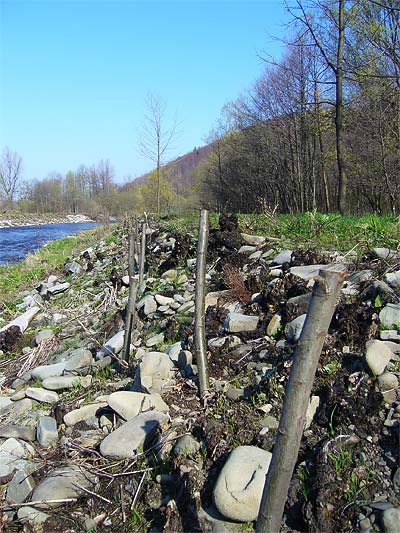
This year’s willows (photo: Š. Kalousová)

The last year of the Project LIFE has started.
The clearing of dry biomass has been realized. Than as in previous years, the out planting of Salix spp. will follow.

Photo: M. Konupka

International Water bird Census in Morávka
The International Water bird Census in Morávka was realised in the term of Project activity F4 at the weekend 16.1. -17. 1. 2009. The sectors in the surrounding of the dam Morávka and from the junction Morávka – Ostravice to Nošovice were mapped. There were watched 8 species of water birds including of critically endangered Common Merganser.
The outcomes of International Water bird Census in Morávka:
5x Grey Heron (Ardea cinerea), 4 x White-throated Dipper (Cinclus cinclus), 101x Mallard (Anas platyrhynchos), 6x Great Cormorant (Phalacrocorax carbo), 2x Great White Egret (Egretta alba), circa 30 x Black-headed Gull (Chroicocephalus ridibundus) and 2 pairs of Common Merganser (Mergus merganser).
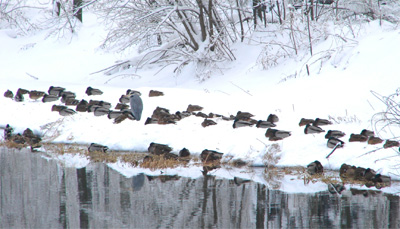
Ardea cinerea and Anas platyrhynchos Photo: Petr Konupka
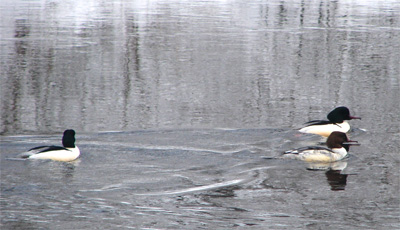
Mergus merganser Photo: Petr Konupka

Conference Raškovice
October 22, 2009 Arbor Day – the date was used by Raškovice Elementary and Nursery School to hold a environmental conference called „Reynoutria sp. Project and Green Gate“. The conference programme consisted especially of children presentations who have participated in this school project. Schoolchildren presented their experience, findings and adventures obtained during Reynoutria sp. mapping. The only adult on the floor was the representative of the „Preservation of Alluvial Forest Habitats in the Morávka River Basin” project presenting results of thi project from the Life programme. No matter near all presentations were executed by pupils of 7th and 8th class of elementary school the conference had a high standard, the impression of schoolchildren presentations was very professional. Beside presentations other children participated in the posters elaboration, younger children at least played sketches inspired by Reynoutria sp. which had been prepared by their teachers and/or they recited own poems on Reynoutria sp. The content of Arbor Day was fulfilled during the conference break and present guests planted out several trees by the school building which schoolchildren will be caring about. The present Life project team members have cordially appreciated both children performing and especially the teacher Ms. Kuriplachova, who can be considered as a driver of the movement in Raškovice school.
For inspiration: Poems on Reynoutria sp. theme having been composed by children (we do not have interpreter such a quality to be able translate poems and not to decrease their effect).
Křídlatka roste mezi strom
a obklopuje naše domy.
Obklopuje ji řeka,
možná že tam i pes štěká.
Že v lese roste také chmel,
to jsem vážně nevěděl.
V lese taky ptáci zpívají,
o kus dál zase žáby hopsají.
Může tam být taky rybník,
třeba se jmenuje Mělník.
Křídlatku musíme označit,
aby se mohla vyhubit.
autor : Zbyšek Stibor
KŘÍDLATKA
Celá třída o pátku,
šla mapovat křídlatku.
Vedle lesa u vody,
v hledání jsou závody.
Venku pěkně slunce svítí,
za křídlatkou vše se řítí.
Jsou to děti ze školy,
v hledání jsou přebory.
Už se pilně blíží k cíli,
hledaj keřík toho býlí.
Už ho našly, jenže běda:
tenhle keřík jíst se nedá!
Proto naši ochranáři,
rozrůstání jeho maří.
Je to dřina, hodně práce,
tahle velká likvidace.
Už to bude v pořádku,
likvidují křídlatku!
autor: Ester Popadičová
KŘÍDLATKA
Stromy, tráva, zelená je,
barvami vše v létě hraje.
Ale jejda, to snad ne,
křídlatka tu zase je.
Jak zbavit se jí, protivy,
kdopak tohle asi ví?
Její květy jsou jako bílý jed,
rozmnoží se všude hned!
Postříkat se musí hned
nebo zničí náš krásný svět.
autor: Tereza Ženatá a Jakub Foldyna
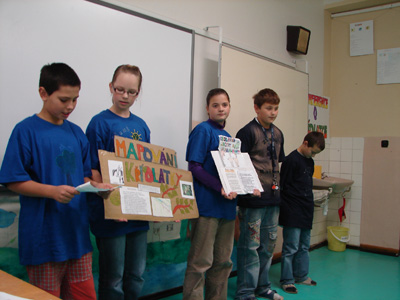
Foto R. Barták
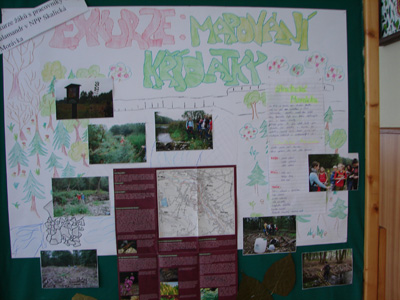
photo R. Barták

photo R. Barták
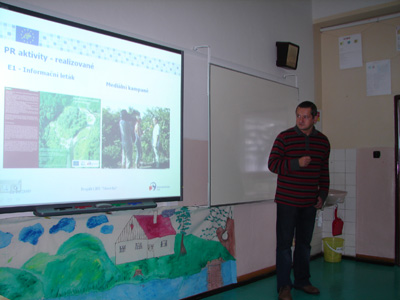
photo R. Barták

Since autumn on-coming the further phase of invasive plant of Reynoutria sp. elimination in Morávka region is considered to be finished. This year (the third one from planned four) Salamandr NGO employees have checked over more than 370 hectars in Morávka river basin and they have found out living Reynoutria sp. individuals to eliminate them subsequently by herbicide.
Situation in Morávka river surroundings at the project beginning (year 2007) and nowadays can be compared by the following pictures:
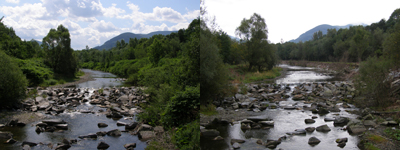
photo R. Barták

photo R. Barták
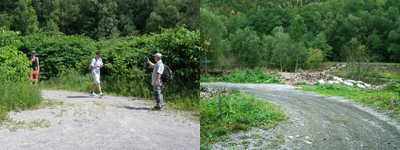
photo R. Barták

Visit European Commission
Two days´ mission of European Commission representatives, including also the control of the project course, took place at the beginning of October. The head of the mission was Ms. Madelinska (the technical desk officer), the other members were Ms. Liptovská – Hobzová and representative of the monitoring team, Mr. Halada. The project team presented current project results as a part of the mission programme, including all significant technical and financial aspects of its execution. The second day the mission representatives visited the project area, having been accompanied by the project team members. Subsequently the European Commission approved the existing success in the project implementation by the letter.
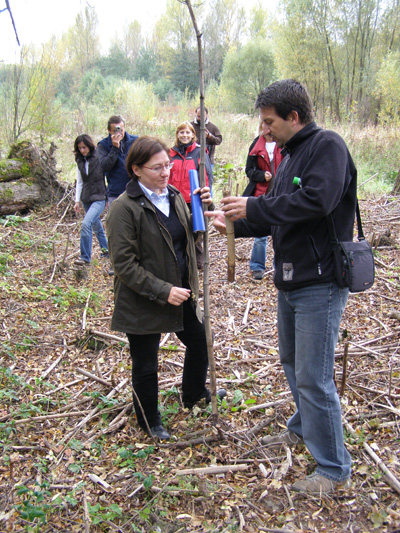
photo R. Barták
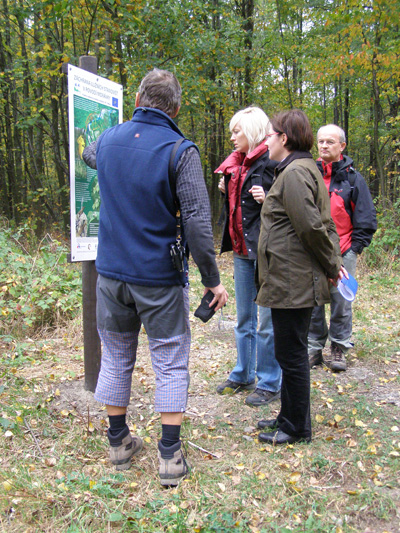
photo R. Barták
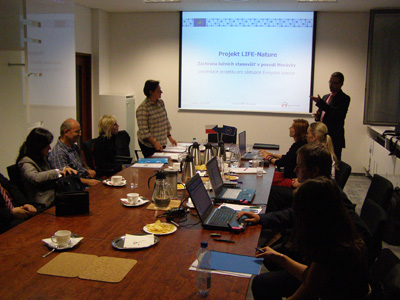
photo R. Barták

At the end of July members of the project implementation team have visited the Reynoutria spp. elimination project which is realized in the Liberec region, in the Nisa and Jizera river basin. The purpose of the visit was to share the experiences in Reynoutria spp. elimination in different regions.
More information about the Liberec region`s project at: http://www.kraj-lbc.cz/priroda
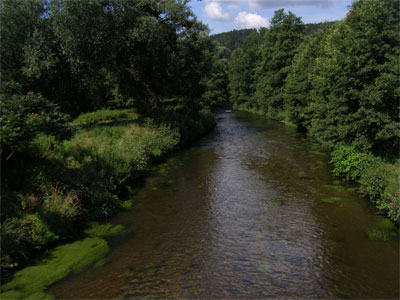
29.7.2009, Nisa river basin, photo: R. Barták
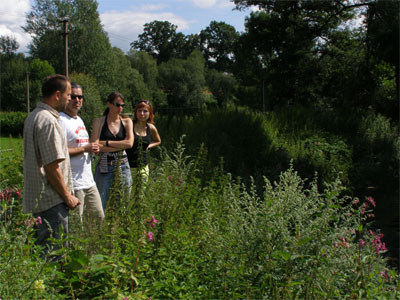
29.7.2009, Nisa river basin, photo: R. Barták

In the term of widening C1 activity the invasive plant Himalayan Balsam (Impatiens glandulifera) was mechanically eliminated (mowing, plucking) during July and October. This till 3 m high plant native to Himalaya occupies vacancy after Reynoutria sp. Because Himalayan Balsam is an annual plant, it is not necessary to eliminate it in a chemical way.

10.7.2009, Pražmo; photo: Š. Kalousová

Prevention of Reynoutria spp. future dispersion
It is very important for the further development of nature in the Morávka river basin to prevent future dispersion of Reynoutria spp. invasive species. It was found out from the former investigation Reynoutria spp. can be found at the sites it hardly could penetrate them by the natural dispersion from river and its tributary banks. They are often isolated sites at the border of plots and/or along to forest roads. It can be supposed the Reynoutria spp. dispersion is an unwanted result of human activity, such as transfer of soil, contaminated by Reynoutria spp., from affected sites to the forest periphery (e.g. as a part of forbidden dumping of waste - “black dumps” and/or filling up hollows and gorges at the plots borders by soil and waste). Another reason can be transfer of contaminated soil by forest machinery in forests. There is another similar risk – the transfer of soil within the building and construction works in the area. Public has to be informed about it and our Life project PR-activities should be directed to solution of this problem.
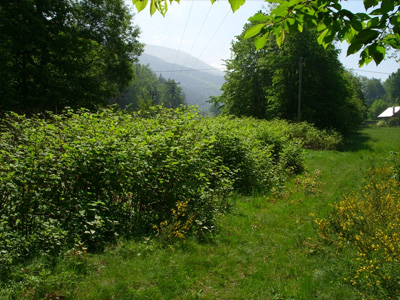
18.6.2009, Vyšní Lhoty; photo: D. Kuriplachová

Cooperation with schools
It is a major task in the third year of the project to find out all spots, which Reynoutria spp. has not been eliminated by the former interventions made in, either it has been omitted during investigation phase of the project and/or it has newly appeared in last two years there. In respect to the scope of the project area and because of often hidden locations there is a actual risk of omitting these sites of future dispersion of the invasive species.
That is why the project team has strongly appreciated a cooperation of the Basic school in Raškovice village, especially the environmental education co-ordinator, the teacher, Ms. Mgr. Dana Kuriplachová, who had offered to the team support of pupils to map recent appearance of invasive species in the Morávka river basin, with focus to Reynoutria spp., during long-term school project (period 2009-2010). Children will map locations, the Reynoutria spp. can be found recently, and they would compare them with locations the Reynoutria spp. is being eliminated within Life project. They will observe a development of nature both affected and non-affected by the Reynoutria spp. The school will inform public on the significance of the Reynoutria spp. elimination for environmental protection by municipal newsletters, regional media, a conference, an exhibition, educational and presentation materials and other activities based on the co-operation the school and parents. Basic school Raškovice will co-ordinate dispersion of the school project activities to the other basic schools in the Morávka river basin, especially to schools in villages of Morávka, Raškovice, Nošovice, Skalice, Dobrá, Staré Město, respectively town of Frýdek – Místek. The result of the school project should be – beside the actual map of invasive species appearance and status in the Morávka river basin creation – a suggestion for the potential measures to prevent future dispersion of invasive species.
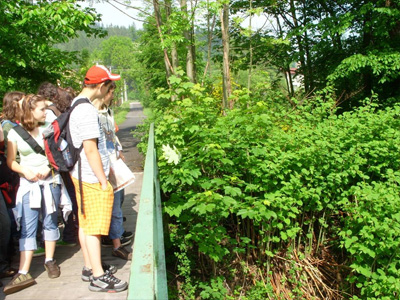
18.6.2009, Vyšní Lhoty; photo: D. Kuriplachová

Botanical interests of Morávka
Several rare plant species are blooming now in the Morávka river basin. First of all it is critically endangered Myricaria germanica. This bush is one of the rarest plants in the Czech Republic. Another now blooming endangered species of plants are Lunaria rediviva (Perennial Honesty) and Orchis mascula (Early Purple Orchid).
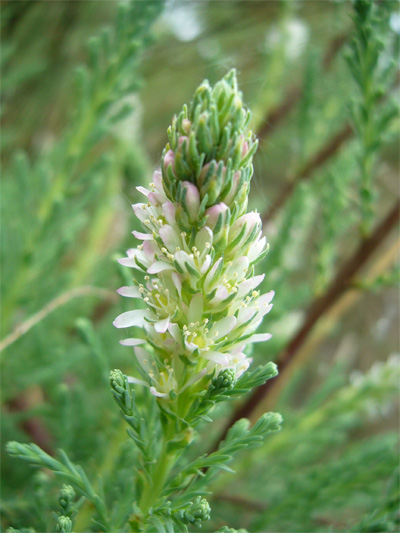
12.5.2009, Vyšní Lhoty; Myricaria germanica; photo: Š. Kalousová
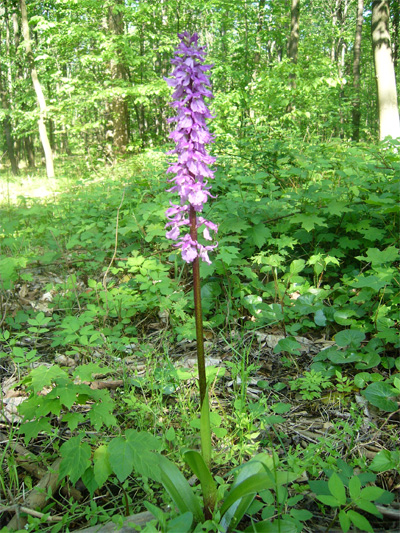
13.5.2009, Morávka; Orchis mascula; photo: Š. Kalousová

Project presentation
24.4.2009 the project LIFE - Preservation of alluvial forest habitats in the Morávka river basin“was presented in the silviculture and nature protection exhibition named „Day in mayor’s forest“in Krhová.

24.4.2009, Krhová photo: Š. Kalousová
Control of experimental plots
In terms of project’s action D1 the spring monitoring of experimental plots were realized. There are more species of plants in the plots in forest. The most frequent flowers are Cardamine glandulosa, Ficaria verna and Anemone nemorosa.

10.4.2009, Vyšní Lhoty, experimental plots; photo: Š. Kalousová
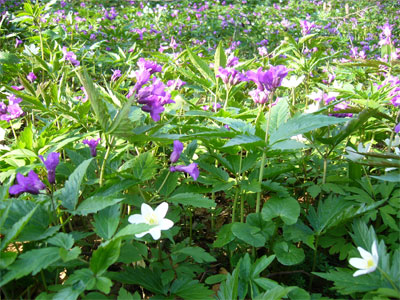
10.4.2009, Vyšní Lhoty, Anemone nemorosa, Cardamine glandulosa ; photo: V. Kalousová

After winter season the fieldwork in the Morávka river basin has started again. From 16.3.2009 the clearing of dry biomass has been realized. The work flow will be depended on the weather.
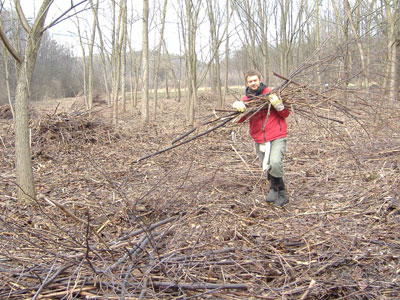
19.3.2009, Raškovice photo: M. Konupka

24.3.2009, Skalice photo: M. Konupka

On March 19 was realized the taking of shrubs cuttings in the Morávka river basin. The shrubs cuttings of Salix purpurea, Salix caprea, Salix fraxilis, Salix viminalis and Salix triandra will be planten in selected areas during April.

19.3.2009, Vyšní Lhoty, Taking of shrubs cuttings photo: R. Barták

Mapping of the European otter (Lutra lutra) in Morávka river
The mapping of the European otter (Lutra lutra) was realized in the Morávka river during winter months. Stay marks (excrements, footprints, slips) of these water mustelids carnivores were observed along whole Morávka river and also on its affluent Slavíč and Mohelnice.
Mapping of the European otter (Lutra lutra) in Morávka river (localization of stay marks; February 2008)
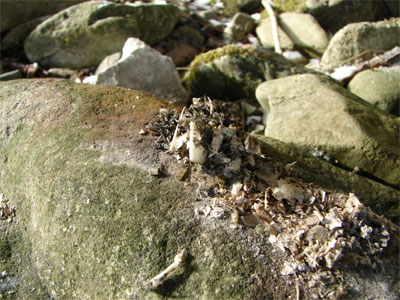
15.2.2009, Morávka - excrements of the European otter photo: P. Konupka
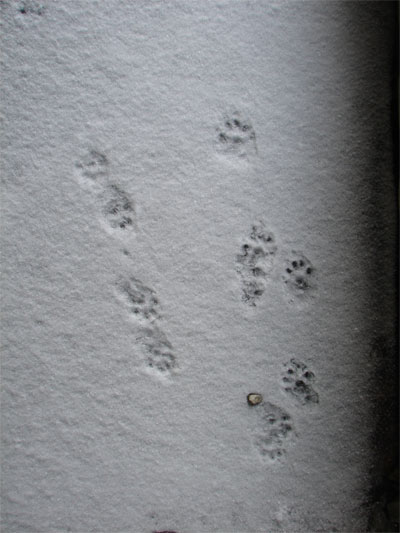
10.2.2009, Morávka - footprints of the European otter photo: P. Konupka

International Water bird Census in Morávka
The International Water bird Census in Morávka was realised in the term of Project activity F4 (Monitoring of the impact of project activities)at the weekend 17.1. -18. 1. 2009. The sectors in the surrounding of the dam Morávka and from the junction Morávka – Ostravice to the Skalická Morávka National natural monument were mapped. There were watched 8 species of water birds including of rare Common Snipe.
The outcomes of International Water bird Census in Morávka:
5x Grey Heron (Ardea cinerea), 3x Eurasian Coot (Fulica atra), White-throated Dipper (Cinclus cinclus), 133x Mallard (Anas platyrhynchos), 5x Great Cormorant (Phalacrocorax carbo), 2x Mute Swan (Cygnus olor), 1x Common Snipe (Gallinago gallinago), 1x Grey Wagtail (Motacilla cinerea).

17.1.2009, Vyšní Lhoty photooto: M. Krupa

The 9th meeting of Management committee took place in January 14th.
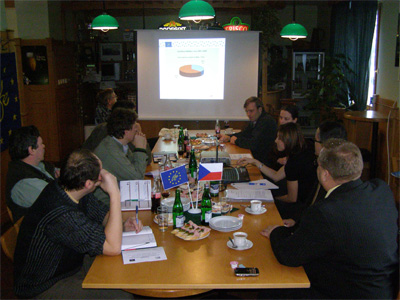
14.1.2009, Nošovice photo: R. Barták

Project presentation
A Portugese TV producing a new TV program about sustainable development in each European country, named "Eco Europa" has shown an interest in our LIFE project as an example of sustainable and eco projects in Czech Republic.

30.12.2008, Vyšní Lhoty photo: Z. Bártová
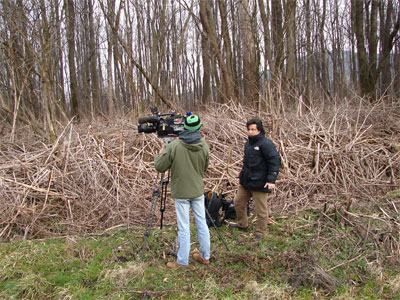
30.12.2008, Vyšní Lhoty photo: Z. Bártová

Year 2008 in Morávka river basin
The end of the second year „fight contra Renoutria“is coming. This year, 260 ha of Renoutria have been spraying by herbicide Roundup Biaktiv. Except this, 16 species of herbs and grasses were sowed on the 3 ha of the project area. Now cleaning of dry biomass is realised in some parts of the project area.
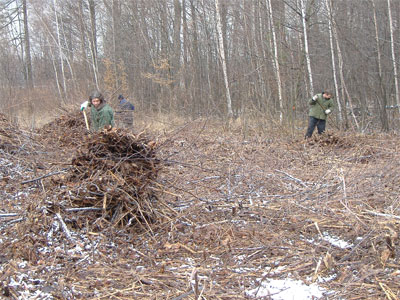
20.11.2008 Cleaning of dry biomass, photo: M. Konupka

The sowing of 16 species of herbs was realised in the framework of action C2: "Revitalization of herb layer of selected habitats" on 3 ha.
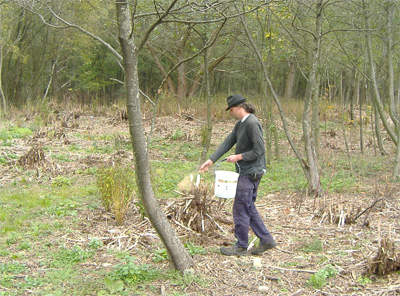
photo:
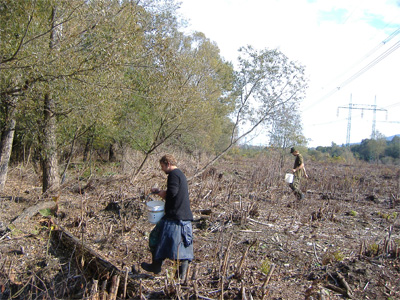
photo:

LIFE+ call for proposals 2008
For this second LIFE+ call for proposals, the deadline for the submission of proposals to the Member States is 21 November 2008. A total amount of €207,5 million is available for this call.For more information on the call, click here.

The Odra River Basin Authority records a short video on the progress of the project
The Odra River Basin Authority is taking part as a partnership organization in the liquidation of knotweed and generating publicity through the media about the project. The short clip on the project was aired on 5/8/2008 by TV Polar during its regional newscasts. Video download here

There's more than spraying going on in Moravka
Most of the area beset by knotweed is being sprayed with herbicide. But there are areas where the application is taking place by injection to protect the environment and natural resources. The herbicide is injected using a special "injection pistol" into the hollow of the stem between knots. Although this technique is used only in small-sized areas, it represents a very important step in protecting valuable localities and acquiring experience with this novel method.
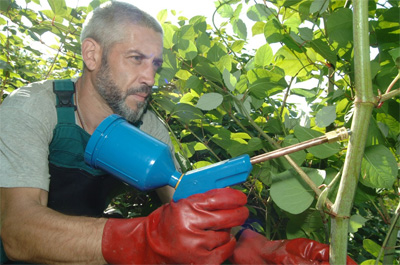
28.7.2008, Vyšní Lhoty photo: Drahoslav Ramík

Project presentation to the media
Press releases are being sent out as part of the media presentation. Press clippings about the project may be read here.
Information about the progress of the project is also being made public using internet media. Internet articles may be found, among other places, on these websites:
enviport.cz
solokapr.cz

PRESS RELEASE, 21 July 2008
The largest project in the Moravian-Silesian Region in the spere of the preservation of nature and the landscape, focused on the elimination of Reynoutria in the Morávka River Basin, has embarked upon a new phase – the second year of its implementation. Reynoutria, which grows to a height of up to 4 metres, occupies approximately 350 hectares at the foot of the Beskydy Mountains. It is an aggressive weed which suppresses the growth of vegetation and causes soil erosion. The total budget for the project, financed with the support of the European Union LIFE-Nature program, is roughly CZK 28 million.
whole document for download is here (.doc)

Dozens of people are heading to the River Morávka to see the progress of the project
The area around the River Moravka is seeing a lot of excitement these days. It's not just a nice weather drawing people into the outdoors. It's also one of the project activities. From May until September, there have been or will be a total of 19 excursions. As part of walks which take various paths along the river and are chosen with regard to the target group of listeners, participants find out not only about the progress of the project but also learn interesting facts about the animate and inanimate nature literally at their fingertips. The excursion paths are chosen so that the first results of the project will be evident and also allow a comparison with areas which have not yet been treated. The target groups are both children in elementary and secondary schools, as well as university students and employees of specialist institutions.
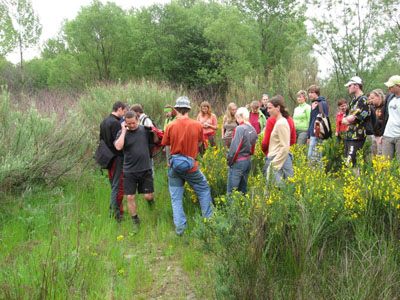
15.5.2008, Vyšní Lhoty – the excursion organized for students of Palacký University in Olomouc photo: B. Jůzová
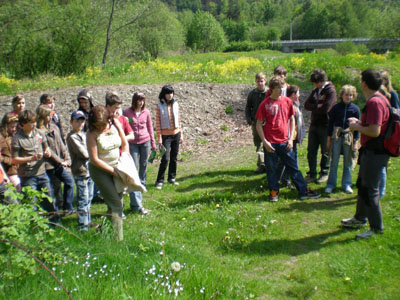
27.5.2008, Raškovice – the excursion organized for children in primary school in Raškovice
photo: Z. Bártová

The second year of Reynoutria liquidation is underway on the Morávka
The end of May saw the second year of the battle against Reynoutria get underway. Workers finished up the cleanup and burning of the dry biomass which they carried out into open areas around the river before returning to attack the Reynoutria once again with herbicide. The main goal of this year's activity is not only to treat all of the area left untreated last year, but also to return to the area which had been treated. Motorized blowers and sprayers were used for the job. To a lesser extent, in especially sensitive locations, injection applicators were also used. In exceptionally overgrown sections, paths were cut using brush cutters. The first were took place in the immediate environs of the Skalická Morávka National Nature Monument and in the town of Morávka. Over the course of time, the treatment will be expanded to take in other areas.
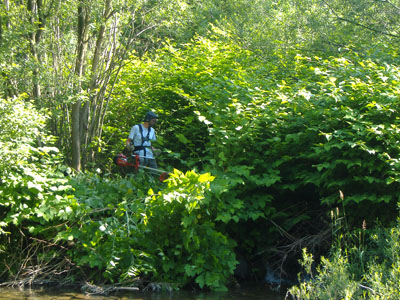
30.5.2008, Vyšní Lhoty - in exceptionally overgrown sections, paths were cut using brush cutters photo: B. Jůzová
news archive
|


